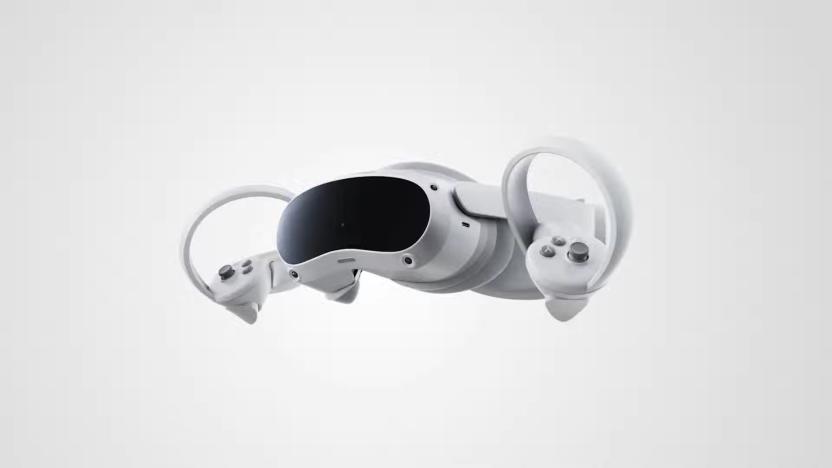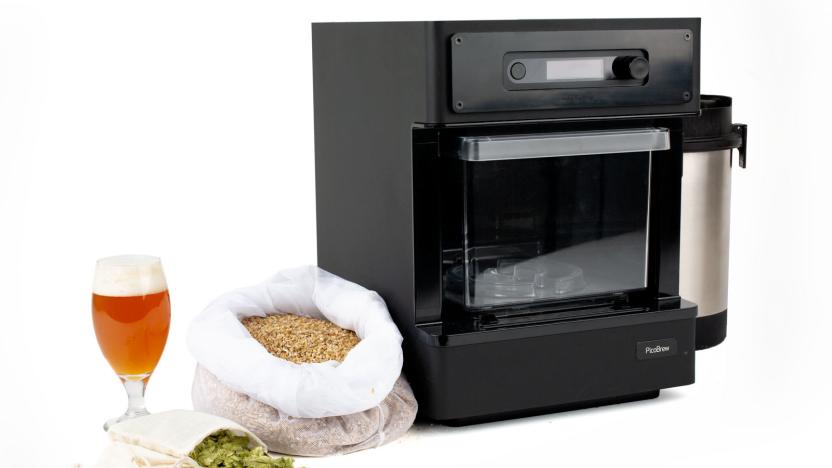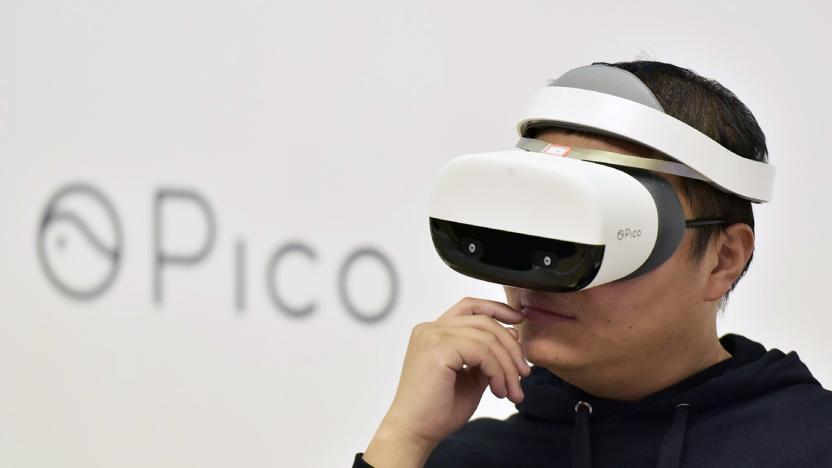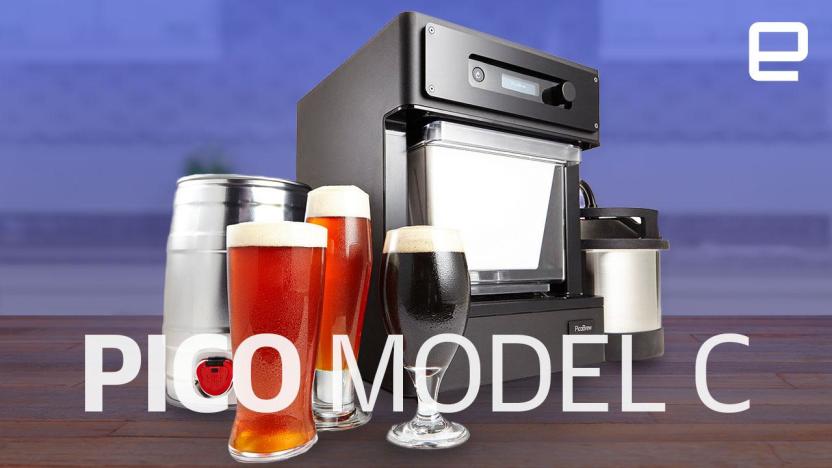pico
Latest

ByteDance's Pico reveals its latest VR headset as it aims to compete with Meta Quest 2
The Pico 4 will arrive in some countries next month for around $420, but a US release hasn't been announced.

PicoBrew's new kits let you homebrew beer with your ingredients
PicoBrew's all-in-one homebrew appliances put a brewery on your countertop. They're relatively easy to use, and give novice beer makers detailed steps to make their own suds -- no previous experience required. There was one huge hindrance for the Pico C, Pico Pro and Pico S though: you couldn't buy ingredients from your local homebrew shop and pop them into these small appliances. You could do that with the $2,500 modular Pico Z, but it simply wasn't an option on the more affordable models. Well, that changes today with the so-called UnPak'd Kit.

Wearable home theater lets you see what's outside
Home theater headsets have come a long way, but there's still a common problem: they tend to dominate your face. It's hard to know when someone wants your attention unless they tap on your shoulder. You might not be quite so cut off in the future, though. Kopin and Pico Interactive have unveiled a wearable home theater prototype, the Eagle, that promises the equivalent of an 80-inch screen while giving you better awareness of the outside world. You probably wouldn't want to walk with this on your head, but it could give you a peek at an approaching person before they say hello.

Pico's standalone 6DoF VR headset is compatible with Vive Wave
You might have missed the original Pico Neo VR headset back in April 2016, but the name is popping up again thanks to its re-release. Following the HTC Vive Focus, the new Pico Neo unveiled earlier today is yet another standalone VR headset with six-degree-of-freedom (6DoF) tracking, and thankfully, it looks a lot better than its predecessor. Much like the Vive Focus, what we have here is a dual-camera inside-out tracking system powered by Qualcomm's Snapdragon 835 (so it's likely based on the same development kit) with the same three-hour battery life, but it features a narrower 101-degree field of view instead of 110, and it packs a pair of 90 Hz 1,440 x 1,600 LCDs instead of AMOLED.

Picobrew's next goal: A safe and affordable DIY distillery
Picobrew has a new, cheaper countertop beer brewing system. That you already knew. But the company is now dipping its toes into distilling. The Picostill is an add on for the Pico Model C that turns that weird custom designed keg into a countertop distillery. Specifically it's a reflux still that uses vacuum distillation, which doesn't look as cool as a pot or column still, but makes far more efficient use of the space.

PicoBrew tries to make countertop beer brewing affordable
Brewing your own beer is surprisingly easy and cheap. But, it can seem intimidating. Plus, some of the equipment takes up a lot of space if you really start to embrace the hobby. Companies like Picobrew have been trying to simplify the process to make it more appealing to newcomers and those with limited space. The Pico Model C is the latest in a line of "countertop" brewing machines. It looks more like a coffee machine than anything else. In fact, it looks a lot like the company's previous machine -- the Pico -- except the stainless-steel body has been replaced with a black powder-coated finish.

The Pico Neo is a dumb VR headset with a smart controller
We're still not sure what the future of VR looks like. Oculus, HTC and Valve are focusing on systems based around powerful gaming PCs. Sony will use its PlayStation 4 as a standardized base for PSVR. Samsung wants you to slot a flagship phone in front of your eyes. Chinese company Pico has a different idea. Its Pico Neo is an all-in-one system that offers an Oculus-like headset, but gets all of its computing power from a controller.

Picobrew takes a stab at automated counter-top homebrew beer
PicoBrew is hoping to do for homebrewed beer what Keurig has done for coffee. It tried previously with the Zymatic, but the $2,000 price tag, intimidating size and complexity limited its appeal. Really the Zymatic ended up being for professional brewers to experiment on and for people with deep pockets looking to dip their toe into homebrewing with the least amount of effort possible. The company's new machine, the Pico attempts to address some of those hurdles. First, off, it's dropped the price dramatically. If you move quickly to pick it up through the Kickstarter campaign launching today it will only cost you $500, though it will climb to $1,000 at retail. Second the Pico is roughly half the size of the Zymatic, and can actually fit on an average counter-top. Though, does still take up a significant amount of space and probably wouldn't find a permanent home next to your coffee machine.

ICYMI: Drone architects, radar attachment for phones & more
#fivemin-widget-blogsmith-image-805596{display:none;} .cke_show_borders #fivemin-widget-blogsmith-image-805596, #postcontentcontainer #fivemin-widget-blogsmith-image-805596{width:570px;display:block;} try{document.getElementById("fivemin-widget-blogsmith-image-805596").style.display="none";}catch(e){}Today on In Case You Missed It: Scientists programmed quadcopters to autonomously construct a basic rope bridge that could support the weight of a person, all part of an effort to use drones when distances or climbing might be necessary. A new Kickstarter campaign takes aim at antiquated radar guns for sports like baseball, adding a smartphone attachment that determines the speed of balls while simultaneously taking video and notes. And a new mini-cartridge startup is targeted at console game lovers. They look like a original Nintendo cartridge but connect into a smartphones audio jack.

Pico: Use your iPhone to program DSLR time-lapse photographs
iOS 8 brought the power of time-lapse photography to a whole new audience, some of whom probably now wish that they could use their digital SLR cameras to shoot higher resolution time-lapse videos. Pico (US$50 minimum pledge) is a Kickstarter campaign from Minnesota-based Mindarin that brings sophisticated time-lapse capabilities to almost any DSLR through a tiny device that you program with your iPhone, then plug into your camera. The Pico team was kind enough to send me a pre-production version of Pico for testing, along with access to a beta version of the iPhone app. When I say that Pico is tiny, I mean it - it's a round "lozenge" about an inch in diameter and about 7/16 of an inch thick, with a standard headphone jack sticking out of one side. Inside the plastic case is a battery that's designed to last for eight years. The entire thing weighs just 0.4 ounces (11 grams), so it's not going to weigh you down. By itself, Pico can't do much other than look like a large cherry cough drop (well, it does have secret powers I'll disclose in a minute, but bear with me here...). But plug it into an iPhone's headphone port and run the app, and suddenly you can program Pico to do amazing things with your DSLR. The Pico app currently provides a simple interface for programming a time-lapse. You enter how long you want to have your camera continue shooting, the interval between exposures, and even a start time if you wish to have the camera begin shooting a specific time. Turn up the volume on your iPhone, press the "Send" button on the app, and it programs the plugged-in Pico device. Now, take the included adaptor cable, plug it into the remote port on your DSLR, and watch the magic happen automatically. What's great about Pico is that you can just set it, put your DSLR on a tripod, and let it get to work without worrying about accidentally bumping your camera. Eventually, the team plans to add some other capabilities to the Pico app: taking multiple photos as varying exposures to help in making High Dynamic Range (HDR) images, adding Bulb Ramping (used to compensate for natural changes in light, like day to night sequences), and Speed Ramping, which adjusts the interval length during the timelapse to speed up or slow down the created video. That secret power of Pico I alluded to earlier? Well, there's a manual mode built in if you don't happen to have your iPhone with you. You just press and hold Pico, and it begins beeping once a second. Count the number of beeps to reach the desire interval, and then just let it continue shooting until you unplug Pico to stop it. For DSLR-owning iPhone users, this is a wonderful accessory that can help you stretch your photographic capabilities. The project is currently 60.5 percent funded with a month to go; let's see if TUAW readers can push this one over the top.

Samsung debuts projector-equipped Galaxy Beam 2 smartphone
Chances are your phone doesn't have a built-in projector -- and it never will. But there's at least a small subset of the Chinese market that apparently has a need for an entry-level smartphone capable of projecting dim videos and presentation slides onto a flat surface. The Galaxy Beam 2 sports a 1.2GHz quad-core processor, 1 gig of RAM and an underwhelming 800x480-pixel 4.66-inch display. The battery tops out at 2,600 mAh of juice, so if you're thinking of planning a smartphone movie marathon you might want to bring the charger along. It launched today on China Mobile's 3G network (with pricing TBA), and while Samsung has yet to detail an international release, it's unlikely that we'll ever see the second-generation Beam on this end of the Pacific.

Texas Instruments shrinks its HD DLP Pico projector chip down to 0.3-inches
We wouldn't say that smartphone projectors have exactly caught fire, Samsung's Galaxy Beam notwithstanding. Part of the problem is the extra bulk required by pico projector components, which is where Texas Instruments comes in with its new HD "Tilt and Roll" DLP Pico chipset. They've now got the size down to about 0.3-inches, or about the size of a pencil-tip as shown above. That should let makers of tablets, smartphones and wearables add 120 Hz projector powers to their devices. It's also the chip used in Avegant's Glyph VR headset -- so it might be beaming a movie directly to your retinas at some point in the future.

Sony laser pico projector module beams out focus-free HD images
If your presentation audience is noticing pixels, then projector resolution may be the least of your problems. Nevertheless, Sony's just introduced a new pico module that'll allow manufacturers to build pocket-sized projectors with high-def, 16:9 images using laser beam scanning (1,920 x 720 with rectangular pixels). That'll bring sharp focus regardless of screen distance, along with high contrast, wider color gamut and reduced laser "speckle," according to Sony. There's also built-in screen distortion correction for off-kilter situations. If you're now scheming about some kind of shark-mounted entertainment system, though, it'll have to wait -- the tech is only available to projector makers.

Fruit Ninja meets real Ninja with CamBoard's Pico gesture camera (video)
You can play Fruit Ninja with your fingertips, you can play it with your eyes, so it's reasonable enough that hand waving should control it too. And while gesture-sensing technology is hardly new, Teutonic outfit pmdtechnologies has been teasing a miniaturized edition of its depth camera that's ripe for embedding into small consumer electronics devices. All we've got so far is a short video (after the break) outlining its potential, but that's enough to hope someone can go head-to-head with Microsoft in the space.

DLP's IntelliBright tech promises brighter pico projection at no extra power
Most portable projectors are tasked with striking a delicate balance between power consumption and picture quality. With this in mind, Texas Instruments' DLP arm has unveiled a new system at MWC known as IntelliBright, which is intended to improve the brightness of pico projectors without making hardware hungrier. It's no fancy set of circuits, though, but a pair of algorithms which tinker with image brightness and contrast to produce a more radiant picture. What's more, the algorithms can be tweaked separately by hardware manufacturers for any desired result, and can incorporate data from ambient light sensors to increase projector efficiency. DLP recently introduced its new Tilt & Roll Pixel chip architecture at CES, which is also designed to make pictures brighter and batteries happier in the next generation of pico products. All we hope is the developments inspire Samsung to create a Galaxy Beam II, just with more focus on the phone part this time

DLP unveils Tilt & Roll Pixel chip architecture, promises brighter projectors with better resolution
Pico projectors are slowly getting better and better as the years go by, and DLP's latest chip architecture announced at CES aims to raise the bar once more. The platform, which the company is dubbing Tilt & Roll Pixel, is the same size as the current generation, but it promises that products will be able to offer twice the resolution, 30 percent higher brightness and 50 percent increase in energy efficiency. Given our fondness for products like the Samsung Galaxy Beam, we're pretty excited to see how good movies look on our living room wall. Don't get too anxious, however -- the new platform is currently sampling to manufacturers and products are expected to arrive "as early as the end of the year." We have the press release for your viewing pleasure past the break. Update: DLP emailed us with an updated press release to confirm the name of the new architecture. We were also informed that chips using WVGA resolution will be slightly smaller, shrinking from 0.3 inches to 0.2. Follow all the latest CES 2013 news at our event hub.

Acer's C120 pico projector goes on sale, ready to be powered by your PC
Unless you had a particularly keen eye for tiny projectors, you may well have missed the announcement of Acer's C120, back at CES. The palm-sized pico projector has now hit the market, weighing in at an ultraportable 6.34 ounces. The peripheral features a USB connection, which can be used to power the device when it's plugged into a PC. The C120's also got a quick-starting LED lamp, which can display presentations in WVGA or WXGA. Business people, teachers and lovers of tiny projectors alike can pick this guy up now for $259. Not sold? Watch a projection-worthy video presentation from CES, after the break.

Mobile Miscellany: week of March 19th, 2012
Not all mobile news is destined for the front page, but if you're like us and really want to know what's going on, then you've come to the right place. This past week, we've spotted the Lumia 610 in two new colors, and the open source community received new goodies from the likes of HTC, Qualcomm and Samsung. These stories and more await after the break. So buy the ticket and take the ride as we explore the "best of the rest" for this week of March 19th, 2012.

Daihatsu Pico concept commuter EV hands-on
Using LEDs to display messages on the back of a car? Looks like we have yet another contender with the same idea, except this time all four sides get an LED panel each. The idea behind Daihatsu's Pico concept EV is that it can interact with surrounding pedestrians and drivers using messages with matching colors. For instance, the LED belt can issue a red warning on the back if a car is following too closely; or when driving past pedestrians in close proximity (think rascal scooters but with front and back seats), the belt can turn green and indicate that the car's limited to a safe top speed of 3.7mph. Other than that, the Pico's very much just a cute little EV with a driving range of up to 31 miles (with a full two-hour charge), plus a top speed of 31mph. We also dig the touchscreen console inside the car, but with just the two LED bars acting as doors, we sure hope it'll withstand a bit of rain. Video after the break. %Gallery-140615%

OmniTouch projection interface makes the world your touchscreen (video)
Sometimes you just want to make notes on your forearm. Put that permanent marker down though, because PhD student Chris Harrison et al at Microsoft Research have created a new system that allows touchscreen interaction on hairy and uneven surfaces. It uses a short-range depth camera instead of the infrared sensor we've seen on similar devices, which allows it to gauge the viewing angle and other characteristics of surfaces being used -- and it can even handle pinch-to-zoom. There's a video after the break, if you fancy a bit of wall-based digital finger painting.














